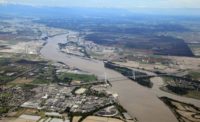Victoria, B.C., Plans New Wastewater Plant
For the first time, secondary treatment of wastewater in Victoria, British Columbia, could become a reality.

The minister of environment for the province of British Columbia approved the Capital Regional District’s (CRD) Core Area Liquid Waste Management Plan in August. Andy Orr, communications manager for the district, says a request for proposals on a new $738-million wastewater treatment facility will go out this fall. Construction on the facility is expected to start in 2011 and could be finished as early as 2016, Orr says.
Currently, Victoria dumps the majority of its sewage directly into the Strait of Juan de Fuca, the body of water separating Vancouver Island from Washington state’s San Juan Island. Although the Capital Regional District uses a screen to block out the largest waste material, it estimates that it dumps approximately 34 million gallons per day of untreated sewage into the strait.
Although Canada has similar requirements to the U.S. for treating wastewater—both nations require secondary treatment—the regulations in Canada are slightly less stringent, says Karen Burgess, municipal unit supervisor for the water-quality program at the Washington Dept. of Ecology’s Northwest Regional Office in Bellevue. Moreover, an exception is permitted for discharge into open marine waters, as in Victoria’s case.
But that may be changing. In 2006, Barry Penner, British Columbia’s minister of environment, called for a plan to treat wastewater in Victoria. After years of protest—Victoria has long contended that the fast-moving waters of the strait whisk away the dangers of the sewage—officials relented and picked McLoughlin Point in Esquimalt over 11 other locations as the site for a new facility.
Penner says his ministry believes the centralized strategy provides a “practical, cost-effective system” that also provides opportunities for resource recovery.
Along with the McLoughlin Point project, the overall plan calls for a new biosolids digester processing facility in the future at the Hartland landfill and new underground storage tanks at the Saanich East facility.
The existing screening facilities at Clover Point and Macaulay Point will add grit-removal facilities and be upgraded to pump wastewater to the McLoughlin site. A second pump station also will be upgraded.
Total capital costs for the entire project are estimated at $782 million, with yearly operating costs of $14.5 million. Plans for a new treatment facility on the West Shore have been deferred until 2030.
The latest plan saves more than $180 million over previous plans because of its centralized configuration.
“A benefit of a centralized plant is the decreased cost,” says Core Area Liquid Waste Management Committee Chairwoman Judy Brownoff. “The McLoughlin option will create a wastewater treatment system for the core area and West Shore that will have a negative carbon footprint that takes advantage of resource-recovery opportunities, meets our current needs and provides for future flexibility.”
Opportunities exist for resource recovery at every facility and will include bio-methane production, heat recovery, phosphorous recovery and dried biosolids as a fuel substitute, Brownoff says.
Heat recovery will occur at the central facility, and there will be an opportunity to explore district heating for areas surrounding McLoughlin Point, including Victoria’s downtown core. Heat recovery from stored effluent in the University of Victoria area is also a possibility from the Saanich East site; the system includes the potential for more than 18,500 tons of carbon offsets per year. Annual resource-recovery revenues are estimated at $3.1 million by 2030, Orr says.
Burgess says that configurations she has seen for the new Victoria plant likely will easily exceed even the United State’s secondary requirements.
CRD Board Chairman Geoff Young says the August decision helps the board secure the needed funding for the project.
Annie Kolb-Nelson, spokeswoman for the King County wastewater division in the Seattle area, says her agency helped Victoria during the site-finding process, identifying technologies and locations that best suited the Victoria region.



